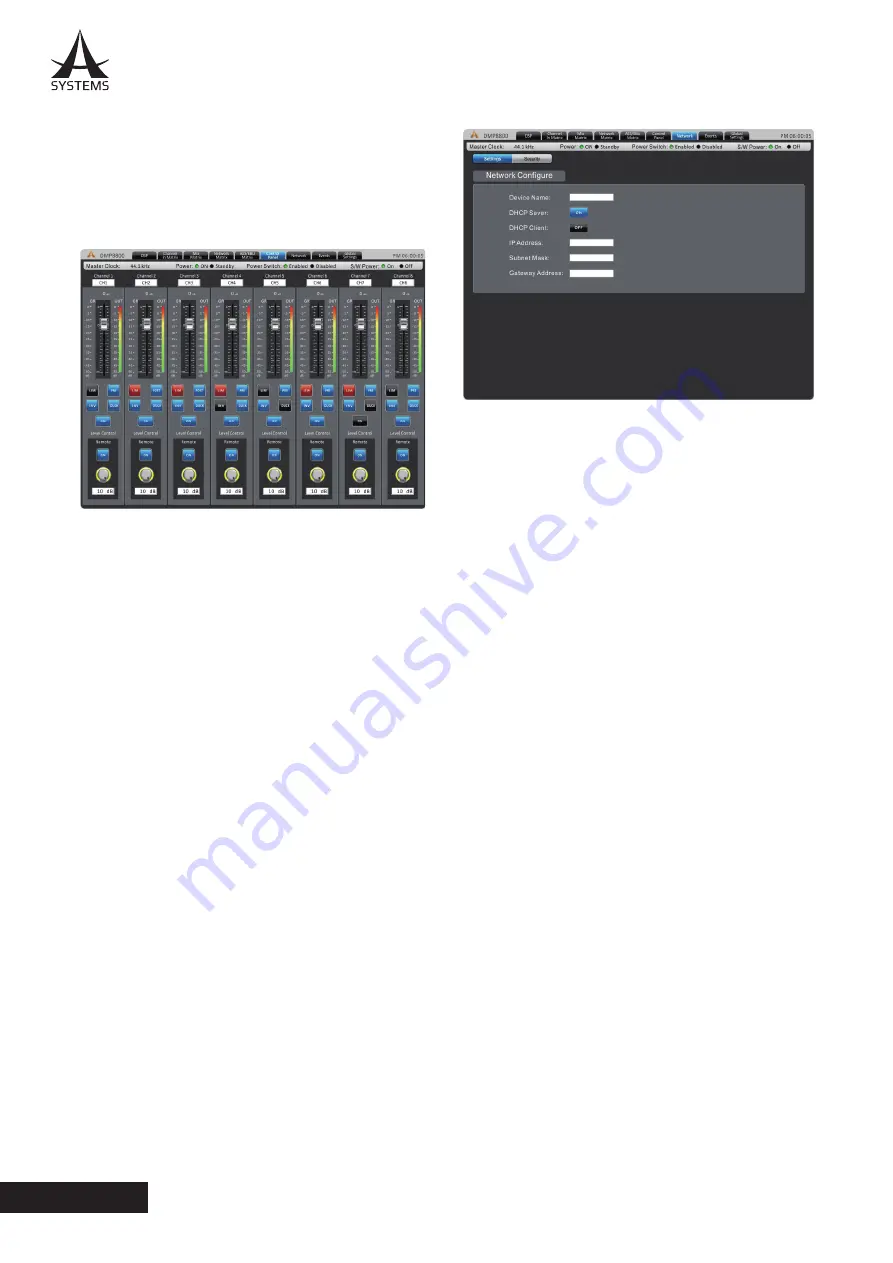
8
DMP8800
English
On:
This button allows you to turn the corresponding
input or output signal on and off� When turned off, the
signal will not be sent to the AES/EBU mix�
Routing:
Each of the 8 analog inputs, 8 matrix inputs, 8
network inputs and 8 matrix outputs, can be assigned to
the DMP8800’s AES/EBU mix�
Control Panel
The control panel menu offers complete control of input
channels� This menu includes level and gain controls,
metering, and a host of other parameters that can be
edited�
Channel Name:
A preselected channel name can be
viewed or edited in this screen�
Fader:
The input level can be adjusted using this
onscreen fader�
Meters:
The input and output signal level of the channel
can be viewed through these meters� They can be
adjusted between pre- and post-fader meters�
Gain Reduction:
The gain reduction meter will provide
a real-time indication of any reduction in gain applied by
the internal DSP processes of the DMP8800 (including
compressors-limiters, equalizers, etcetera).
Limiter:
This button will activate the internal limiter
function for the corresponding channel�
Duck:
Activate the ‘ducking’ feature by pushing this
button� The duck function can be activated as ducker 1,
ducker 2, or off, the settings of which are decided by their
respective menus�
INV:
This button will invert the phase of the corresponding
signal�
CH ON:
This button will turn the corresponding channel
on and off�
Remote Gain Controls
: The control panel menu offers
a remote gain control for each channel� The gain control
indicates that set by a remote level control and can be
edited using the DMP8800’s software�
GAIN ON:
All remote gain controls can be deactivated
using these buttons�
Total Att.:
This section will indicate the total amount
of attenuation applied to an input signal, expressed in
decibels�
Network
When using the DMP8800 remote software – either
within the local area network or through the internet –
the network settings need to be set appropriately to allow
external computers to identify and connect to it�
Device Name:
The name of the current device is found
here� This can be adjusted by the user if necessary�
DHCP Server/Client:
Users can activate DHCP
– Dynamic Host Configuration Protocol – on the
DMP8800� The DMP8800 can be selected as either a
client or a server� When your local network runs off a
DHCP protocol, the network will automatically assign
your DMP8800 an IP address� If your network runs off a
DHCP server, you can turn it on using the DHCP Client
button� If you wish to set your DMP8800 as the DHCP
server, turn it on here�
IP Address:
When not using a DHCP server, you can
enter an IP address for your DMP8800 here� Otherwise
it will be automatically assigned� If entering your own
IP address, Asystems suggests 192�168�x�99 – where
“x” could be determined by your local area network’s
settings� Check network settings on other computers on
the same network for this value�
Subnet Mask:
The subnet mask for your DMP8800
can be entered into this field. For most networks – and
particularly if you’re unsure what it is – this should be
kept set as “255�255�255�0”�
Gateway Address:
A gateway is a device that can
connect other devices in a network that use different
types of protocols� This is typically your router, but a
computer could also serve as a gateway�
Current Users:
At the bottom of the page, a list of
currently connected users will be displayed� This list will
include the user name, the IP address of the user and
the level of access they’re afforded�
Summary of Contents for DMP8800
Page 1: ...User s Manual Manual del Usuario Digital Matrix Processor DMP8800 ...
Page 23: ...1 DMP8800 Español ...
Page 42: ......
Page 43: ......
Page 44: ...www asystems sys com ...

























